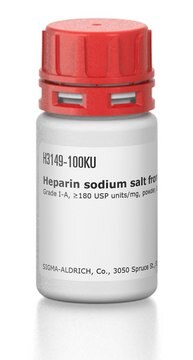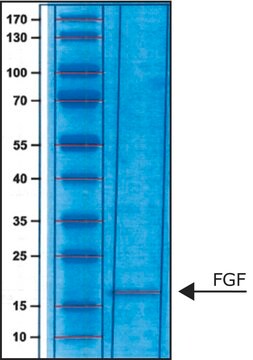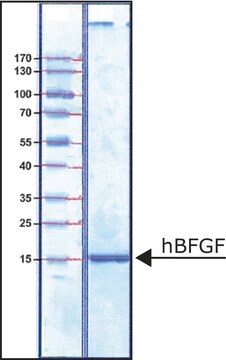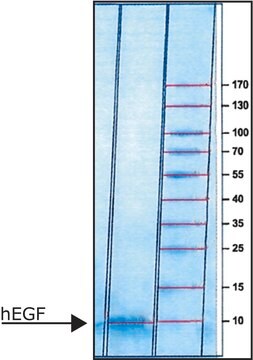F8424
Fibroblast Growth Factor-4 human
≥95% (SDS-PAGE and HPLC), recombinant, expressed in E. coli, lyophilized powder, suitable for cell culture
Synonym(e):
hFGF-4, FGF-4, K-FGF
About This Item
Empfohlene Produkte
product name
Fibroblast Growth Factor-4 human, FGF-4, recombinant, expressed in E. coli, lyophilized powder, suitable for cell culture
Biologische Quelle
human
Qualitätsniveau
Rekombinant
expressed in E. coli
Assay
≥95% (SDS-PAGE and HPLC)
Form
lyophilized powder
Wirksamkeit
≤10.0 ng/mL
Qualität
endotoxin tested
Mol-Gew.
19 kDa
Verpackung
pkg of 25 and 100 μg
Lagerbedingungen
avoid repeated freeze/thaw cycles
Methode(n)
cell culture | mammalian: suitable
Verunreinigungen
<1 EU/μg
UniProt-Hinterlegungsnummer
Lagertemp.
−20°C
Angaben zum Gen
human ... FGF4(2249) , FGF4(2249)
Suchen Sie nach ähnlichen Produkten? Aufrufen Leitfaden zum Produktvergleich
Allgemeine Beschreibung
Anwendung
- To maintain trophectoderm stem cells.
- In neurogenic differentiation.
- In hepatocyte differentiation.
Biochem./physiol. Wirkung
Physikalische Form
Hinweis zur Analyse
Lagerklassenschlüssel
11 - Combustible Solids
WGK
WGK 3
Flammpunkt (°F)
Not applicable
Flammpunkt (°C)
Not applicable
Persönliche Schutzausrüstung
Eyeshields, Gloves, type N95 (US)
Analysenzertifikate (COA)
Suchen Sie nach Analysenzertifikate (COA), indem Sie die Lot-/Chargennummer des Produkts eingeben. Lot- und Chargennummern sind auf dem Produktetikett hinter den Wörtern ‘Lot’ oder ‘Batch’ (Lot oder Charge) zu finden.
Besitzen Sie dieses Produkt bereits?
In der Dokumentenbibliothek finden Sie die Dokumentation zu den Produkten, die Sie kürzlich erworben haben.
Artikel
Fibroblast growth factors in cell culture and various growth factors for your research
Unser Team von Wissenschaftlern verfügt über Erfahrung in allen Forschungsbereichen einschließlich Life Science, Materialwissenschaften, chemischer Synthese, Chromatographie, Analytik und vielen mehr..
Setzen Sie sich mit dem technischen Dienst in Verbindung.






